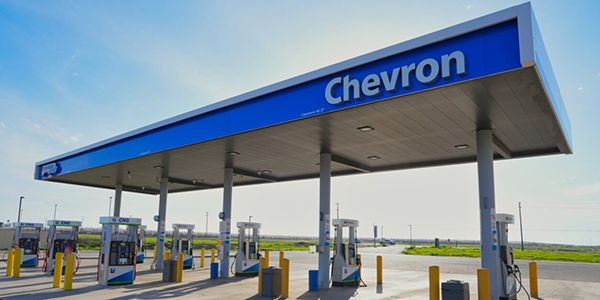FREQUENTLY ASKED QUESTIONS
Compressed Natural Gas


CNG is natural gas (methane) that is stored and transported under high pressure in its gaseous state. When compared to conventional diesel, CNG has many advantages:
• Lower price*
• Lower carbon intensity based on reduced emissions across its production life cycle
• Lower engine emissions of NOx and particulate matter
*Like all products, pricing subject to fluctuation.
Source Chevron internal sales sheet: Lower Carbon Fact Sheet_CNG_FINAL 08.04.23.pdf
Renewable natural gas, or RNG, is biogas that has been upgraded and placed in the conventional natural gas system. It’s produced from multiple sources, including livestock waste, landfills, wastewater sludge, food waste and other organic waste operations. RNG can be used for electricity generation, thermal functions like heating and cooking, bioplastics, and vehicle fuel.
Bacteria naturally break down organic waste and produce raw methane, carbon dioxide (CO2) and other gases. The process is called “anaerobic digestion.” Raw methane is upgraded to remove contaminants for commercial use.
After the methane is upgraded, RNG can then be injected and transported through natural gas pipeline networks and used as a substitute that is virtually indistinguishable from natural gas. The difference is RNG is produced from biological materials instead of fossil fuel deposits.
Sources:
The three types of CNG infrastructure are time-fill, gas-fill, and a combination of both. The main difference between time-fill and gas-fill systems are the amount of storage capacity available and the size of the compressor which determines the amount of fuel dispensed and the time it takes for CNG to be delivered.
Source: Alternative Fuels Data Center: Compressed Natural Gas Fueling Stations (energy.gov
Generally, fast-fill stations are best suited for retail situations where vehicles arrive randomly and need to fill up quickly. Per the Alternative Fuels Data Center (AFDC), all public CNG stations have a fast-fill option. Fast-fill stations receive fuel from a local utility line at a low pressure and then use a compressor on site to compress the gas to a high pressure. Once compressed, the CNG moves to a series of storage vessels, so the fuel is available for a quick fill-up. CNG can also be delivered via dispensers alongside gasoline or other fuel dispensers.
CNG at fast-fill stations is often stored in the vessels at a high service pressure (4,300 psi), so the dispenser can deliver it to a vehicle quickly. The dispenser uses sensors to calculate pressure and measure the number of gasoline gallon equivalents (GGEs) delivered to the tank, taking temperature into account.
Chevron and Beyond 6 CNG stations are fast-fill stations.
Source: Alternative Fuels Data Center: Compressed Natural Gas Fueling Stations (energy.gov)
As reported in March 2020, natural gas powers more than 175,000 vehicles in the United States and roughly 23 million vehicles worldwide. Natural gas vehicles (NGVs) are good choices for high-mileage, centrally fueled fleets because they can provide similar fuel range support for applications that stay within a region supported by reliable compressed natural gas (CNG) fueling. For vehicles that travel long distances, liquefied natural gas (LNG) offers a greater energy density than CNG, meaning the fuel range is more comparable to conventional fuel. Some of the advantages of natural gas as a transportation fuel include its domestic availability, widespread distribution infrastructure, and reduced greenhouse gas emissions over conventional gasoline and diesel fuels.than 175,000 vehicles in the United
States and roughly 23 million vehicles worldwide.
The horsepower, acceleration, and cruise speed of NGVs are comparable with those of equivalent, conventionally fueled vehicles. Also, compared with conventional diesel and gasoline vehicles, NGVs can offer other air quality benefits beyond greenhouse gas emissions.
Source: Alternative Fuels Data Center: Publications (energy.gov), Natural Gas Vehicle Basics (energy.gov)
Renewable Diesel


Renewable diesel is a renewable fuel that can be used in conventional diesel engines as an alternative to petroleum diesel. It is primarily made from non-petroleum renewable sources such as soybean oil, used cooking oil, tallow and other plant- and animal based oils, with a maximum of 0.1% of its composition deriving from conventional petroleum diesel. Renewable diesel is processed in a refinery, similarly to conventional diesel and meets the same standard ASTM D975 specification. Renewable diesel is 100% comparable to conventional Diesel No. 2 and is often referred to as “Biomass-based” diesel. The orange, regulatory decal indicates the percentage of renewable diesel that the fuel contains.
*ASTM International, is an international standards organization that develops and publishes voluntary consensus technical standards for a wide range of materials, products, systems, and services including Petroleum Products, Liquid Fuels, and Lubricants.
Yes, Chevron Renewable Diesel meets the same ASTM D975 specification as Diesel No. 2. I am at a dispenser that identifies the fuel as Diesel No. 2 and only has an orange label that says it contains a certain percentage of biomass-based diesel. What does this mean?
Since Renewable diesel meets ASTM D975 specification, it is Diesel No. 2. Renewable diesel is often referred to as “Biomass-based”diesel because of the renewable sources it is made from. The orange decal indicates that the fuel contains a percentage of renewable diesel which is typically 95% or 99%. Despite how the federally required language on the bottom of the decal may read, this fuel does NOT contain 95% or 99% biodiesel.
Chevron Renewable Diesel has physical properties that benefit the combustion process in diesel engines, resulting in lower engine out emissions of hydrocarbons, carbon monoxide, and particulates than conventional petroleum diesel.
Chevron Renewable Diesel is sourced primarily from renewable sources and has a lower carbon intensity on a life cycle basis. This means a lower sum of greenhouse gases emitted throughout the full fuel life cycle calculated under California’s Low Carbon Fuel Standard methodology. Because Chevron Renewable Diesel is derived from renewable feedstocks, it has a lower lifecycle CI than conventional diesel.
Renewable Diesel Blend


Chevron’s renewable diesel blend is a diesel fuel made with 80% renewable diesel and up to 20% biodiesel, typically with no more than 1% conventional petroleum diesel. Chevron Renewable Diesel Blend provides a lower life cycle carbon intensity than conventional petroleum diesel under California’s Low Carbon Fuel Standard. Chevron Renewable Diesel Blend meets or exceeds industry standards and conforms with ASTM* D7467. According to the California Air Resources Board as of end Q4 2022, renewable and biodiesel made up 47% of all diesel sales in California.
Since the product contains between 6% and 20% biodiesel, states require that the official name include Biodiesel B20. As such, labels near product prices (e.g., price signs, dispenser IDs) will identify the product as "Renewable Biodiesel B20." The product is also commonly called R80-B20.
Chevron’s Renewable Diesel Blend may be blended to contain additional petroleum diesel in certain geographies to help manage cold flow properties. As an example, in the Pacific Northwest, the blend ratio introduced in September 2023 is 55% renewable diesel, 20% biodiesel, and 25% petroleum diesel. The higher concentration of petroleum diesel can help to maintain flow if the fuel is exposed to freezing temperatures for extended periods.
*ASTM International, is an international standards organization that develops and publishes voluntary consensus technical standards for a wide range of materials, products, systems, and services including Petroleum Products, Liquid Fuels, and Lubricants.
The terms renewable diesel and biodiesel are often used interchangeably, although they are produced differently. Both renewable diesel and biodiesel are derived from the same feedstocks. Feedstocks are the raw materials used to create the fuel and can include soybean oil, used cooking oil, tallow and other plant- and animal-based oils. The primary difference is in the way each is processed into a fuel which affects their composition.
Renewable diesel is a renewable fuel that can be used in conventional diesel engines as an alternative to petroleum diesel. It is primarily made from non-petroleum renewable feedstocks such as soybean oil, used cooking oil, tallow and other plant- and animal-based oils, with a maximum of 0.1% of its composition deriving from conventional petroleum diesel. Renewable diesel is processed in a refinery, similarly to conventional diesel and meets the same standard ASTM D975 specification. Renewable diesel is 100% compatible with conventional Diesel No. 2 and is often referred to as “Biomass-based” diesel. The orange, regulatory decal indicates the percentage of renewable diesel that the fuel contains.
Biodiesel is an alternative fuel made primarily from non-petroleum renewable feedstocks such as soybean oil, used cooking oil, tallow and other plant- and animal-based oils. These feedstocks are processed to produce the raw, degummed oil which is then reacted with methanol in a processing plant to produce biodiesel. This resulting biodiesel is suitable for blending with renewable and conventional petroleum diesel to produce blends typically ranging from 5% (B5) to 20% (B20).
Chevron Renewable Diesel Blend has physical properties that benefit the combustion process in diesel engines, resulting in lower engine-out emissions of hydrocarbons, carbon monoxide, and particulates than conventional petroleum diesel.
Chevron Renewable Energy Group spent over six years developing a next-generation, high quality biodiesel that is produced using advanced refining processes and testing procedures for blending with renewable diesel to create Chevron Renewable Diesel Blend. Chevron Renewable Diesel Blend is sourced primarily from renewable feedstocks and has a lower carbon intensity on a life cycle basis. This means a lower sum of greenhouse gases emitted throughout the full fuel life cycle calculated under California’s Low Carbon Fuel Standard methodology. Because Chevron Renewable Diesel Blend is primarily derived from renewable feedstocks, it has a lower lifecycle Carbon Intensity (CI) than conventional diesel.
Chevron Renewable Diesel Blend also has a greater cetane number than conventional petroleum diesel which can also improve cold start performance in certain engines, and high lubricity which can minimize friction between and damage to surfaces in relative motion under load.
Yes. Chevron Renewable Diesel Blend can be used interchangeably with conventional diesel in most modern vehicles.1 The product meets or exceeds the ASTM D7467 specification for diesel fuels with biodiesel blended up to a 20% level, commonly referred to as B20. Almost all major engine manufacturers have approved the use of B20. Some exceptions may include older model year equipment.
If temperatures are cold enough, blended renewable diesel fuel, as with other diesel fuels, may begin to freeze and form solid material that can clog vehicle fuel filters, potentially interfering with vehicle operability. During these times, Chevron and its suppliers may lower the biodiesel or renewable diesel content and increase the petroleum diesel content in the product to help avoid this possibility and ensure good cold temperature performance. Diesel blends for use in locations with daytime high temperatures below freezing are recommended to contain petroleum diesel as part of the blend.
1Please check your owner’s manual before using. Manufacturer’s recommendations vary and may include reduced fuel system and lubrication system maintenance intervals, cautions against long term storage, and cautions when operating below freezing temperatures.
The product will be labeled as “Renewable Biodiesel B20” and will also be identified as Chevron Renewable Diesel Blend. There will be a blue label on the dispenser with the percentage range of the biodiesel in the blend. There will also be an orange label with the percentage of renewable diesel that is identified as “Biomass-Based Diesel”. *Both these labels and the language on them are required by the Federal Trade Commission.
* Chevron Renewable Diesel Blend is at least 80% renewable diesel (orange label) and up to 20% biodiesel (blue label). Despite how the federally required language on the bottom of the label may read, this fuel does NOT contain 80% biodiesel. In some geographies, the blend ratios of Chevron Renewable Diesel may be altered to include petroleum diesel to manage cold flow properties. The orange label will be changed to reflect the change in blend ratio.
Chevron Renewable Diesel Blend is produced from a variety of renewable feedstocks, which can affect the color of the fuel. It is normal for fuel color to vary. This product meets or exceeds industry standards and conforms with ASTM D7467.